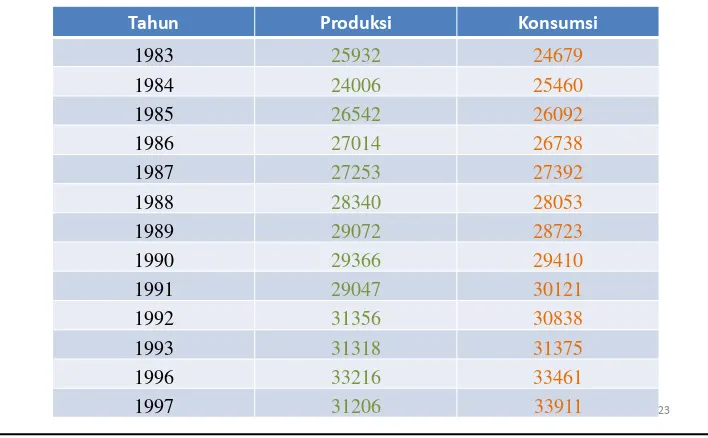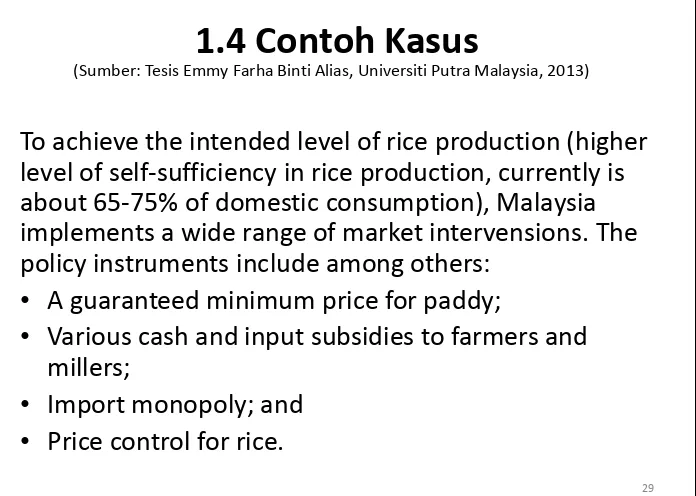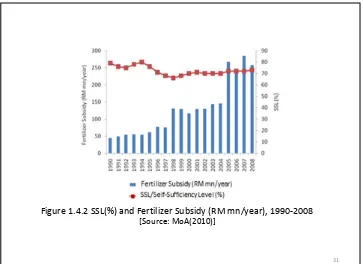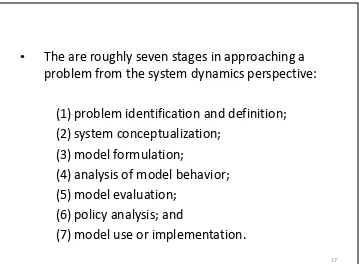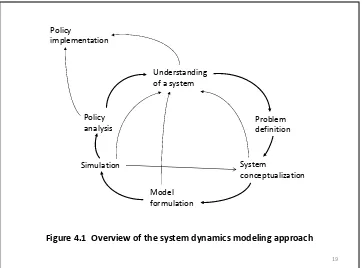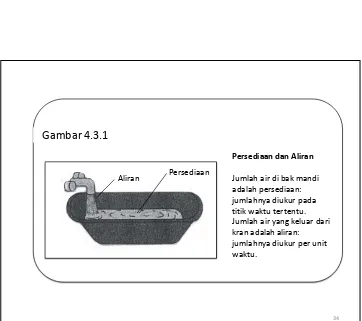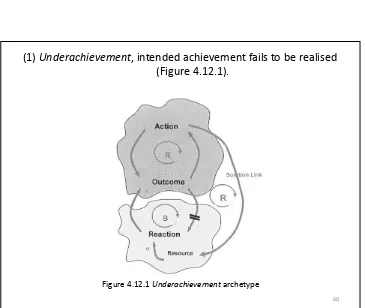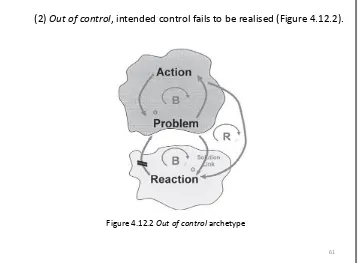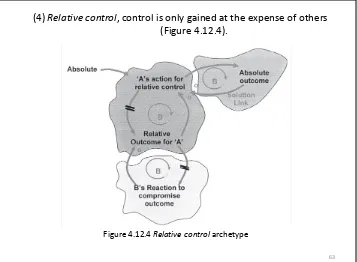Metodologi
System Dynamics
(Dinamika Sistem)
untuk
Pemodelan Kebijakan:
Suatu Pengantar
Dr. Muhammad Tasrif
Ina Juniarti
07.30 – 08.00 Pendaftaran dan Pembukaan 08.00 – 10.00 Sesi 1: Fenomena
10.00 – 10.15 Rehat kopi
10.15– 12.15 Sesi 2: Struktur, Perilaku dan Analisis Kebijakan 12.15 – 13.00 Ishoma
13.00 – 15.00 Sesi 2: Struktur, Perilaku dan Analisis Kebijakan (lanjutan) 15.00 – 15.15 Rehat kopi
15.15 – 17.15 Sesi 2: Struktur, Perilaku dan Analisis Kebijakan (lanjutan)
Selasa 15 Desember 2015
08.00 – 10.00 Sesi 3: Inventory Simulation Game
Rabu, 16 Desember 2015
08.00 – 10.00 Sesi 5: Feedback Loop, Delay dan Nonlinearity (lanjutan)
Kamis, 17 Desember 2015
08.00 – 10.00 Sesi 8: Model Ketersediaan (Availability) 10.00 – 10.15 Rehat kopi
10.15 – 12.15 Sesi 8: Model Ketersediaan (Availability) (lanjutan) 12.15 – 13.00 Ishoma
13.00 – 15.00 Sesi 9: Model Energi 1 15.00– 15.15 Rehat kopi
15.15 – 17.15 Sesi 9: Model Energi 1 (lanjutan)
Jumat, 18 Desember 2015
Sesi 1
Fenomena
1
Outcomes
Pada akhir sesi ini, peserta dapat:
•
memahami konsep suatu fenomena dan sistem;
•
memahami perbedaan antara fenomena sosial
(
social phenomenon
) dengan fenomena alam atau
fenomena fisik (
physical phenomenon
); dan
1.1 Fenomena
•
Fenomena
adalah
sesuatu yang dapat
kita lihat, alami dan
rasakan atau
something
experienced: a fact or
occurrence that can be
observed.
3
Fenomena
• Fenomena fisik adalah fenomena yang tidak melibatkan campur tangan manusia atau keputusan manusia
(fenomena alam atau fenomena yang dibuat manusia
berdasarkan hukum alam)[a natural phenomenon involving
the physical properties of matter and energy (physical
law)].
• Fenomena sosial adalah segala sesuatu yang dipengaruhi oleh kegiatan atau aktivitas manusia yang diwujudkan oleh keputusan-keputusannya (proses pegambilan keputusan)
[anything that influences or is influenced by organisms
sufficiently alive to respond to one another (desicion
Fenomena Alam (Fisik)
9
Tabel Produksi dan Konsumsi Beras Nasional
Tahun Produksi Konsumsi
1983 25932 24679
Tabel Produksi dan Konsumsi Beras Nasional
Tahun Produksi Konsumsi
0
Suatu fenomena menyangkut
2 hal (aspek):
(1) Struktur (structure) Perilaku (behavior) (2)
(unsur pembentuk fenomena dan pola
keterkaitan antar unsur tersebut)
(perubahan suatu besaran/variabel dalam suatu kurun waktu tertentu, baik
kuantitatif maupun kualitatif)
C A
D B
Tahun Produksi padi (ton/tahun)
Fenomena sosial : struktur fisik; dan
struktur pembuatan keputusan.
1.2 Sistem
Suatu sistem adalah suatu fenomena yang strukturnya
telah diketahui [
A phenomenon which its structure has
been defined
].
Atau
Suatu sistem merupakan suatu gabungan dari beberapa
bagian yang bekerja untuk tujuan bersama. Suatu sistem
dapat terbentuk dari sejumlah orang dan/atau sejumlah
komponen fisik [
A
system
means a grouping of parts that
operate together for common purpose. A system may
include people as well as physical parts
].
27
1.3 Persoalan (Problem)
• Suatu fenomena yang kehadirannya tidak diinginkan,
contoh: produktivitas padi yang terus menurun, tingkat pengangguran yang terus bertambah.
• Suatu fenomena yang ingin diwujudkan. Contoh: suatu
target surplus beras yang ingin dicapai pada tahun 2014.
• (secara praktis) Suatu kesenjangan(gap) antara keadaan
sebenarnya (actual state) dengan keadaan yang
1.4 Contoh Kasus
To achieve the intended level of rice production (higher
level of self-sufficiency in rice production, currently is
about 65-75% of domestic consumption), Malaysia
implements a wide range of market intervensions. The
policy instruments include among others:
•
A guaranteed minimum price for paddy;
•
Various cash and input subsidies to farmers and
millers;
•
Import monopoly; and
•
Price control for rice.
(Sumber: Tesis Emmy Farha Binti Alias, Universiti Putra Malaysia, 2013)
29
Figure 1.4.1 Planted Paddy area (‘000 ha) and Productivity (t/ha/year)
Figure 1.4.2 SSL(%) and Fertilizer Subsidy (RM mn/year), 1990-2008
[Source: MoA(2010)]
31
Figure 1.4.3 The Global Model
Sesi 2
Struktur, Perilaku, dan Analisis
Kebijakan
1
Outcomes
Pada akhir sesi ini, peserta dapat:
•
memahami 2 aspek suatu fenomena (struktur dan
perilaku);
•
mengenali struktur fisik dan struktur pembuatan
keputusan;
•
memahami konsep kompleksitas; dan
2.1 Dua Aspek Suatu Fenomena
(1) Struktur (structure) Perilaku (behavior) (2)
(unsur pembentuk fenomena dan pola
keterkaitan antar unsur tersebut)
(perubahan suatu besaran/variabel dalam suatu kurun waktu tertentu, baik
kuantitatif maupun kualitatif)
C A
D B
Tahun Produksi padi (ton/tahun)
Fenomena sosial : struktur fisik; dan
struktur pembuatan keputusan.
Pemahaman hubungan struktur dan perilaku sangat diperlukan dalam
mengenali suatu fenomena.
3
A Picture of an Economy
• Households, firms, and governments make economic decisions. Households decide how much of their labor, land, capital, and entrepreneurial ability to sell or rent in exchange for wages, rent, interest, and profits. They also decide how much of their income to spend on the various types of goods and services available. Firms decide how much labor, land, and capital to hire and how much of the various types of goods and services to produce. Governments decide which goods and services they will provide and the taxes that households and firms will pay.
• These decisions by households, firms, and governments are coordinated in markets—
Contoh : Pengisian air ke dalam gelas sampai penuh.
(Sumber: “The Fifth Discipline”, Peter M. Senge, 1990)
5
Kemungkinan Perilaku
A. Jika sumber air mencukupi
0 1 2 3 4 5 6 7 8
0 1 2 3 4 5 6 7 8 9 10
Volume air dalam gelas
Kemungkinan Perilaku
B. Jika sumber air terbatas
0 dalam gelas Volume air dalam gelas yang diinginkan
Volume air dalam gelas
7
Gap yang dirasakan
Aliran air ke dalam gelas Posisi keran
Volume air dalam gelas Volume air dalam
gelas yang
diinginkan delay Sumber
air
Struktur Fenomena
Gap yang dirasakan
Aliran air ke dalam gelas Posisi keran
Volume air dalam gelas Volume air dalam
gelas yang
diinginkan delay Sumber
air
Struktur Fisik
Struktur Fenomena
dalam gelas Posisi keranVolume air dalam gelas Volume air dalam
gelas yang
diinginkan delay Sumber
air
Struktur Fisik
Struktur Pembuatan Keputusan
Struktur Fenomena
Struktur: (1) pembuatan keputusan; dan
(2) fisik.
Struktur pembuatan keputusan Proses pembuatan keputusan
Kaidah (rule)
Informasi Keputusan
(aksi)
Proses pembuatan keputusan (Teori pembuatan keputusan)
Struktur fisik Hukum alam
Keadaan (actual state) Keadaan yang
diinginkan(goal)
Lainnya
11
• Struktur terdiri atas struktur fisik (stok dan jaringan aliran materi) dan struktur pengambilan keputusan
(decision-making structure) bermacam aktor di dalam sistem.
• Struktur pengambilan keputusan di sini dimaksudkan sebagai kaidah-kaidah pembuatan keputusan dan sumber informasi yang digunakan untuk pembuatan keputusan tersebut.
• Oleh karena itu, model untuk analisis kebijakan dalam kasus suatu fenomena sosial haruslah merupakan suatu
• Exponential Growth
• Goal Seeking
• S-Shaped Growth
• Oscillation
• Growth with Overshoot
• Overshoot and Collapse
2.2 Pola Karakteristik Perilaku Sistem
13
2.3 Konsep Kompleksitas
(Sterman, J.D., Business Dynamics: Systems Thinking and Modeling for a Complex World, 2004, Mc Graw HIll)
(1) Struktur Perilaku (2)
(unsur pembentuk fenomena dan pola keterkaitan antar unsur tersebut)
(perubahan suatu besaran/variabel dalam suatu kurun waktu tertentu, baik kuantitatif maupun kualitatif)
•
Detail complexity
Complexity in terms of the number of
elements (components) in a phenomenon
(system), or the number of combinations one
must consider in making a decision.
•
Dynamic complexity (Kompleksitas Dinamis)
Arises from the relationships (interactions)
among the agents (elements) over time.
15
Kompleksitas dinamis muncul karena fenomena
mempunyai karakteristik:
•
Dynamic
Heraclitus said, “All is change.” What appears to be unchanging is,
over alonger time horizon, seen to vary. Change in systems occurs at many time scales, and these different scales sometimes interact. A star evolves over billions of years as it burns its hydrogen fuel, then can explode as a supernova in seconds. Bull markets can go on for years, then crash in a matter of hours.
•
Tightly coupled
The actors in the system interact strongly with one another and with the natural world. Everything is connected to everything else. As a famous bumper sticker from the 1960s proclaimed, “You
•
Governed by feedback
Because of the tight couplings among actors, our actions feed back on themselves. Our decisions alter the state of the world, causing changes in nature and triggering others to act, thus giving rise to a new
situation which then influences our next decisions. Dynamics arise from these feedbacks.
•
Nonlinier
Effect is rarely proportional to cause, and what happens locally in a system (near the current operating point) often does not apply in distant regions (other states of the system). Nonlinearity often arises from the basic physics of systems: Insufficient inventory may cause you to boost production, but production can never fall below zero no matter how much excess inventory you have. Nonlinearity also arises as multiple factors interact in decision making: Pressure from the boss for greater achievement increases your motivation and effort-up to the point where you perceive the goal to be impossible. Frustration then dominates motivation and you give up or get a new boss.
17
•
History-dependent
Taking one road often precludes taking others and determines where you end up (path dependence). Many actions are irreversible: You can’t unscramble an egg (the second law of thermodynamics). Stocks and flows (accumulations) and long time delays often mean doing and undoing have fundamentallydifferent time constants: During the 50 years of the Cold War arms race the nuclear nations generated more than 250 tons of weapons-grade plutonium (239Pu)T. he half life of 239Pu is about 24,000 years.
• Self Organizing
•
Adaptive
The capabilities and decision rules of the agents in complex systems change over time. Evolution leads to selection and proliferation of some agents while others become extinct. Adaptation also occurs as people learn from experience, especially as they learn new ways to achieve their goals in the face of obstacles. Learning is not always beneficial, however.
•
Counterintuitive
In complex systems cause and effect are distant in time and space while we tend to look for causes near the events we seek to explain. Our attention is drawn to the symptoms of difficulty rather than the underlying cause. High leverage policies are often not obvious.
•
Policy resistant
The complexity of the systems in which we are embedded over whelms our ability to understand them. The result: Many seemingly obvious solutions to problems fail or actually worsen the situation.
19
•
Characterized by trade-offs
2.4
Pertanyaan Terhadap Perilaku
(Fenomena)
(a) Berapakah nilai (angka) besaran itu pada suatu titik
waktu yang akan datang? [point prediction]
(prakiraaan, prediksi masa depan)
(b) Mengapa perubahan besaran tersebut seperti itu? (why ?) Dan dengan cara bagaimanakah
mengubahnya? (how?) [behavior prediction]
(menyusun strategi dan memformulasikan kebijakan, analisis kebijakan atau policy analysis)
21
2.5 Strategi dan Kebijakan
Tujuan
Strategi
Program
Aktivitas diwujudkan dengan
diimplementasikan melalui berbagai
direalisasikan dengan melaksanakan
•Policy statements
•Policy instruments
•Policy measures Kebijakan
diungkapkan dalam bentuk
M
Sebuah rencana (metode) aksi untuk
mencapai suatu tujuan tertentu [
a plan
(method) of action to achieve a particular
Kebijakan
• menciptakan serta membangun iklim dan kondisi yang perlu untuk mendukung (to facilitate) pelaksanaan strategi;
• memberikan kepastian kepada unsur-unsur dunia usaha, masyarakat luas, dan peyelenggara
pemerintahan; tentang arah, ruang lingkup, dan tingkat keleluasaan masing-masing di dalam memilih upaya yang berkaitan dengan strategi tersebut.
Petunjuk-petunjuk (
directives
) yang dikeluarkan
dan disebarluaskan (oleh pemerintah) dengan
tujuan:
25
Pelaksanaan Kebijakan
Untuk melaksanakan kebijakan, setelah mengeluarkan
kebijakan (pernyataan),
policy measures
harus dibentuk:
• bentuk, rumuskan, dan keluarkan instrumen-instrumen kebijakan (hukum, peraturan, petunjuk-petunjuk);
• bentuk dan dirikan badan-badan administratif dan prosedur-prosedur untuk mencatat (to administer) kegiatan-kegiatan yang berkaitan dengan pelaksanaan kebijakan; dan
Proses Pendekatan Perumusan Kebijakan
Pengamatan analitik tentang dunia nyata (deskriptif)
Kegiatan dan rencana untuk merealisasikan strategi Arahan dasar bagi tindakan untuk mencapai tujuan Keinginan (desired) yang
ingin dicapai
27
Kebijakan Publik
[Wibawa, Samodra (2011), Politik Perumusan Kebijakan Publik, Graha Ilmu – Yogyakarta]
Kebijakan publik adalah keputusan suatu “sistem politik” negara, provinsi, kabupaten dan desa, atau RW dan RT untuk/dalam/guna mengelola suatu masalah (persoalan) atau memenuhi suatu kepentingan publik, di mana pelaksanaan keputusan itu membutuhkan dikerahkannya sumberdaya milik semua warga (publik) sistem politik tersebut.
Ability to
•
Fenomena Gunung Es (
The Iceberg Phenomenon
)
Fenomena gunung es (the iceberg) ini menggambarkan bahwa sturktur yang sistematis merupakan fondasi terbentuknya suatu pola (patterns) dan kejadian (events). Namun struktur sistematis tersebut sulit untuk dilihat. Sering kali kita hanya melihat kejadiannya saja (puncak dari gunung es), dan hal tersebut menjadi dasar pengambilan keputusan. Padahal kejadian (events) hanyalah merupakan akibat (hasil) suatu struktur. Sehingga keputusan yang dibuat berdasarkan kejadian (events) tidak akan menyelesaikan suatu persoalan.2.6 Logical framework (approach)
(Sumber: Innovation Associates) 29
Reaktif Saat ini Mengamati kejadian
“Bagaimana cara
tercepat untuk merespon
kejadian ini?”
Adaptif
Mengamati pola perubahan tersebut, apakah
terdapat pengulangan?”
Perubahan Masa depan
Causal loop diagrams dan metode systems thinking lainnya
“Struktur seperti apakah yang menyebabkan
terbentuknya pola tersebut?” Kejadian
Struktur Pola
Tindakan Waktu
Cara Pemahaman
Pertanyaan yang dapat diajukan
•
Tingkatan Pemahaman (
Levels of understanding
)
2.7
Model Untuk Analisis Kebijakan
31
Unknown process
Real world decisions
Real world history
Model
structure behavior Model
•
Pemodelan kebijakan (policy modelling)Kerangka Pemikiran (Pendekatan)
Policy (intervention)? Real world (fenomena)
•
Model suatu fenomena adalah deskripsi (penjelasan
atau gambaran) struktur fenomena tersebut yang
dinyatakan (diungkapkan) menggunakan
bentuk-bentuk media yang dapat dikomunikasikan.
•
Iconic model
(patung dan maket),
graphical model
(grafik dan gambar),
mathematical model
(persamaan matematik),
tabular model
(tabel
input-output/tabel I-O yang menyatakan transaksi
antar-industri dalam suatu perekonomian), dan
computer
model
(model matematik yang dapat dioperasikan
atau disimulasikan).
33
•
Setiap manusia secara naluriah menggunakan suatu
model untuk membuat suatu keputusan (kebijakan),
model mental
. Model mental tidak lengkap dan
kabur. Konsep sistem dan interpretasi terhadap
hubungan-hubungan yang ada di dalam sistem, tidak
kita miliki secara lengkap. Selanjutnya, model mental
sering kali tidak adaptif terhadap
konsekuensi-konsekuensi dinamis yang muncul.
•
“...
the human mind is not adapted to interpreting
how social systems behave. Our social systems
Keputusan berdasarkan model mental,
35
hasil yang tidak diharapkan!
Prinsip-Prinsip Pemodelan Kebijakan
• Model yang memenuhi syarat dan mampu dijadikan sarana analisis untuk merumuskan (merancang) kebijakan haruslah merupakan suatu wahana untuk menemukan jalan dan cara intervensi yang efektif dalam suatu sistem (fenomena).
• Melalui jalan dan cara intervensi inilah perilaku sistem yang diinginkan dapat diperoleh (perilaku sistem yang tidak diinginkan dapat dihindari).
• Model yang dibentuk untuk tujuan seperti di atas haruslah memenuhi syarat-syarat berikut:
37
• karena efek suatu intervensi (kebijakan), dalam bentuk perilaku, merupakan suatu kejadian berikutnya; maka untuk melacaknya, unsur (elemen) waktu perlu ada (dynamic);
• mampu mensimulasikan bermacam intervensi dan dapat
memunculkan perilaku sistem karena adanya intervensi tersebut;
• memungkinkan mensimulasikan suatu intervensi yang efeknya
dapat berbeda secara dramatik: (1) dalam konteks waktu (efek jangka pendek vs jangka panjang, trade offs in time), dan (2) dalam konteks sektoral (efek memperbaiki performance suatu sektor yang berakibat memperburuk performance sektor yang lain, trade offsbetween sectors); disebut dengan istilah dynamic complexity (kompleksitas dinamik);
• perilaku sistem di atas dapat merupakan perilaku yang pernah dialami dan teramati (historis) ataupun perilaku yang belum pernah teramati (pernah dialami tetapi tidak teramati atau belum pernah dialami tetapi kemungkinan besar terjadi); dan
• Keadaan yang diinginkan dan keadaan yang terjadi harus secara eksplisit dinyatakan dan dibedakan di dalam model;
• Adanya struktur stok dan aliran dalam kehidupan nyata harus dapat direpresentasikan di dalam model;
• Aliran-aliran yang secara konseptual berlainan cirinya harus secara tegas dibedakan di dalam menanganinya;
• Hanya informasi yang benar-benar tersedia bagi aktor-aktor di dalam sistem yang harus digunakan dalam pemodelan
keputusan-keputusannya;
• Struktur kaidah pembuatan keputusan di dalam model haruslah
sesuai (cocok) dengan praktek-praktek manajerial; dan
• Model haruslah robust dalam kondisi-kondisi ekstrem.
Prinsip-Prinsip Membuat Model
Dinamik
(Sterman, 1981)39
Kesahihan (
validity
) Model
• Dalam hubungannya dengan kesahihan (validity) model, suatu model haruslah sesuai (cocok) dengan kenyataan empirik (realitas) yang ada.
• Model merupakan hasil dari suatu upaya untuk membuat tiruan kenyataan tersebut (Burger, 1966).
• Upaya pemodelan haruslah memenuhi (sesuai dengan) metode
ilmiah. Saeed (1984) telah melukiskan metode ilmiah ini berdasarkan kepada konsep penyangkalan (refutation) Popper (1969).
• Metode ini menyaratkan bahwa suatu model haruslah mempunyai
Patterns recognized Decision rules
experienced
Induction
Contact point for comparison Unknown process
Real world decisions
Real world history
Model structure
Model behavior
Deductive logic
Metode Ilmiah (Saeed, 1984)
(epistemological: how our knowledge claims could be justified)
41
Usaha pertama dari penyelidikan ilmiah adalah upaya untuk memahami bagaimana suatu perilaku dunia nyata muncul dari strukturnya. Karena tidak ada cara langsung yang dapat digunakan untuk mengetahuinya, suatu model yang mewakili struktur dunia nyata itu harus dikonstruksikan dan perilakunya kemudian diperoleh melalui logika deduktif.
FENOMENA
ANALISIS
STRUKTUR •unsur pembentuk
•pola keterkaitan
FUNGSI-FUNGSI YANG DAPAT DITEGAKKAN
POLA LAKU (behavior pattern)
MEMANFAATKAN
MENGOPERASIKAN
MENGENDALIKAN
MEMBENTUK ATAU MENCIPTAKAN STRUKTUR-STRUKTUR BARU DGN MENGUBAH STRUKTUR ATAU MENSINTESIS DGN STRUKTUR LAIN METODOLOGI
Dengan melakukan
diketahui
Sumber: Sasmojo (2000)
Analisis
FENO MENA LAIN
43
Dua (2) kesukaran:
1) menentukan batas-batas model (model
boundary); dan
2) menentukan struktur pembuatan keputusan.
Saeed (1982):
• Pendekatan kotak hitam (black box approach), hubungan-hubungan struktural biasanya dicari melalui suatu proses deduksi dari data historis tentang perilaku sistem. Penentuan variabel-variabel yang penting yang harus masuk dalam model ditentukan melalui pengujian-pengujian statistik berdasarkan data historis perilaku sistem tersebut.
Alternatif lain adalah memodelkan struktur proses
pembuatan keputusan aktor-aktor dalam sistem
(fenomena) berdasarkan struktur informasi sistem yang
di dalamnya terdapat aktor-aktor, sumber-sumber
informasi, dan jaringan aliran informasi yang
menghubungkan keduanya.
•
analogi fisik, sumber informasi merupakan suatu
tempat penyimpanan (
storage
/
stock
), sedangkan
keputusan merupakan aliran yang masuk ke atau
keluar dari tempat penyimpanan itu.
•
analogi matematik, sumber informasi dinyatakan
sebagai variabel keadaan (
state variable
), sedangkan
keputusan merupakan turunan (
derivative
) variabel
keadaan tersebut.
45Proses Pembuatan Keputusan
Informasi yang terakumulasi dalam sistem
Informasi
Struktur: (1) pembuatan Keputusan; dan
(2) fisik.
Struktur pembuatan keputusan Proses pembuatan keputusan
Kaidah (rule)
Informasi Keputusan
(aksi)
Proses pembuatan keputusan (Teori pembuatan keputusan)
Struktur fisik Hukum alam
Keadaan (actual state) Keadaan yang
diinginkan(goal)
Lainnya
47
Proses pembuatan keputusan menyangkut fenomena-fenomena yang dinamis. Fenomena dinamis ini dimunculkan oleh adanya struktur fisik dan struktur pembuatan keputusan yang saling berinteraksi.
• Struktur fisik dibentuk oleh akumulasi (stok) dan jaringan aliran orang, barang, energi, dan bahan.
• Struktur pembuatan keputusan dibentuk oleh akumulasi (stok) dan jaringan aliran informasi yang digunakan oleh aktor-aktor (manusia) dalam sistem yang menggambarkan kaidah-kaidah proses pembuatan keputusannya.
Sesi 3
Inventory Simulation Game
1
Outcomes
3.1 The Inventory Game (1)
•
The Inventory Game is one of a number of
management simulators developed at MIT's Sloan
School of Management for these purposes. The game
was developed by Sloan's System Dynamics Group in
the early 1960s as part of Jay Forrester's research on
industrial dynamics. Its has been played all over the
world by thousands of people ranging from high school
students to chief executive officers and government
officials.
•
The game is played by teams of at least four players,
often in heated competition, and takes from one to
one and a half hours to complete. A debriefing session
of roughly equivalent length typically follows to review
the results of each team and discuss the lessons
involved.
3
The Inventory Game (2)
• The purpose of the game is to understand the distribution side dynamics of a multi-echelon supply chain used to
distribute a single item. The aim is to meet customer demand of goods through the distribution side of a multi-stage supply chain with minimal expenditure on back orders and inventory. • Players can see each other's inventory but only one player
sees actual customer demand. Verbal communication between players is against the rules so feelings of confusion and disappointment are common.
• Players look to one another within their supply chain
frantically trying to figure out where things are going wrong. Most of the players feel frustrated because they are not getting the results they want.
The Inventory Game (3)
•
Suatu ilustrasi yang memperlihatkan bahwa
perilaku suatu fenomena (sistem) ditentukan
terutama oleh struktur internalnya.
Flow of Goods
5
• Setiap policy-maker mempunyai kebebasan sepenuhnya untuk menentukan ordering policy dalam aturan-aturan sebagai
berikut ini.
1. Pengiriman barang harus memenuhi semua order, sepanjang stok barang dalam inventory memungkinkan untuk keperluan itu. 2. Diberlakukan struktur biaya (cost):
o Carrying cost adalah $ 0.50 per unit/period; dan
o Out-of stock costs adalah $ 2.00 per unit/period.
• Agar biaya total minimum, setiap sektor dalam sistem harus berupaya menjaga agar stok dalam inventory-nya seminimum mungkin, tetapi cukup untuk dapat memenuhi permintaan yang boleh jadi berubah.
• Setiap policy-maker harus dapat menjawab 2 (dua) pertanyaan berikut ini.
1. Apakah stok yang dimiliki dalam inventory cukup untuk memenuhi permintaan? (kenyataan)
2. Berapa banyak barang yang harus dipesan ke pemasok dan cukup untuk menghindari terjadinya out-of-stock?
(kebijakan atau policy)
7
3.2 Langkah-Langkah Permainan
Langkah 1
a. Kirim barang dari inventory ke sektor sebelah kiri, sesuai dengan permintaan yang tertera di order backlog. Barang diletakkan pada bagian kanan shipping delay sektor sebelah kiri. Bila barang yang harus dikirim tidak tersedia simpan secarik kertas sebagai penanda. (Untuk sektor retailer simpan barang terkirim pada customers decks, sedangkan sektor factory kirim seluruh barang yang berada di inventory ke distributor).
b. Jika pengiriman sesuai dengan permintaan, buang catatan pesanan dari order backlog. Jika pengiriman tidak sesuai dengan permintaan, catat kekurangan pengiriman dengan menambahkannya pada order backlog.
Langkah 2: Catat jumlah inventory dan order backlog pada formulir yang telah disediakan. Langkah 3: Pindahkan barang-barang pada bagian kirim shipping delay ke inventory.
Langkah 4: Pindahkan barang-barang dari sebalah kanan ke sebelah kiri dari shipping delay [termasuk memindahkan barang pada sektor factory: 4(a) and 4(b)].
Langkah 5:Tentukan jumlah barang yang akan dipesan, dan simpan pada bagian kiri dari mail box di sektor sebelah kanan.
Langkah 6: Catat pesanan pada formulir yang disediakan.
Orders
(Order rate)
Inventory
Shipping delay 2
(Record inventory)
Customers (Record order)
9
Order backlog 2 (Record backlog)
1(b) Order discard
rate 5 (Order rate)
Inventory
Shipping delay 2
(Record inventory) 3
4
WHOLESALER
1 (a)
7
Mail delay 8
Shipments to retailer
Order (Order rate)
Inventory
Shipping delay 2
(Record inventory) 3
4
DISTRIBUTOR
1 (a)
7
Mail delay
Shipments to wholesaler
6 (Record order)
11
Inventory 2 (Record inventory) 1 (a)
Mail delay 8 Orders from
distributor
Sesi 4
Systems Thinking
&
System Dynamics
1
Outcomes
Pada akhir sesi ini, peserta dapat:
•
mengenali hubungan sebab akibat;
Pengisian air ke dalam gelas sampai penuh
(Sumber: “The Fifth Discipline”, Peter M. Senge, 1990)
3
Kemungkinan Perilaku
A. Jika sumber air mencukupi
0 1 2 3 4 5 6 7 8
0 1 2 3 4 5 6 7 8 9 10
Volume air dalam gelas
Kemungkinan Perilaku
B. Jika sumber air terbatas
0 dalam gelas Volume air dalam gelas yang diinginkan
Volume air dalam gelas
5
Gap yang dirasakan
Aliran air ke dalam gelas Posisi keran
Volume air dalam gelas Volume air dalam
gelas yang
diinginkan delay Sumber
air
Struktur Fenomena
Gap yang dirasakan
Aliran air ke dalam gelas Posisi keran
Volume air dalam gelas Volume air dalam
gelas yang
diinginkan delay Sumber
air
Struktur Fisik
Struktur Fenomena
dalam gelas Posisi keranVolume air dalam gelas Volume air dalam
gelas yang
diinginkan delay Sumber
air
Struktur Fisik
Struktur Pembuatan Keputusan
Struktur Fenomena
Metodologi Pemodelan
Struktur Perilaku unsur pembentuk
pola keterkaitan antar unsur :
(1) feedback (causal loop) (2) stock (level) dan flow (rate) (3) delay
(4) nonlinearity
(ontological: the ways reality itself could be)
Pendekatan Struktural
Systems Thinking System Dynamics
Systems Thinking
dan
System Dynamics
9
A. Source:
System Dynamics Home Page.htm
11
System Dynamics Methodology
•
System dynamics is a methodology for studying and
managing complex feedback systems, such as one finds
in business and other social systems.
•
In fact it has been used to address practically every sort
of feedback system.
•
While the word system has been applied to all sorts of
situations, feedback is differentiating descriptor here.
•
Feedback refers to the situation of X affecting Y and Y
in turn affecting X perhaps through a chain of causes
and effects.
•
One cannot study the link between X and Y and,
independently, the link between Y and X and predict
how the system behave. Only the study of the whole
system as a feedback system will lead to correct
results.
What is the relationship of
Systems Thinking to System Dynamics?
•
Systems thinking looks at the same type of problems
from the same perspective as does system
dynamics.
•
The two techniques share the same causal loop
mapping techniques.
•
System dynamics takes the additional step of
constructing computer simulation models to
confirm that the structure hypothesized can lead to
the observed behavior and to test the effects of
alternative policies on key variables over time.
13
B. Source:
Richardson, George P. & Alexander L. Pugh III
(1981),
Introduction to System
Dynamics Modeling
Overview of the System Dynamics
Approach
•
The system dynamics approach to complex problems
focuses on feedback processes. It takes the
philosophical position that feedback structures are
responsible for the changes we experience over time.
The premise is that
dynamic behavior is
consequence of system structure
and will become
meaningful and powerful. At this point, it may be
treated as a postulate, or perhaps as a conjecture yet
to be demonstrated.
•
As both a cause and a consequence of the feedback
perspective, the system dynamics approach tends to
look
within
a system for the sources of its problem
behavior. Problems are not seen as being caused by
external agents outside the system.
15
• Inventories are not assumed to oscillate merely because consumers periodically vary their orders. A ball does not bounce merely because someone drops it. A pendulum does not oscillate merely because it was displaced from the vertical. The system dynamicist prefers to take the point of view that these systems behave as they do for reasons
internal to each system. A ball bounces and a pendulum oscillates because there is something about their internal structure that gives them the tendency to bounce or oscillate.
• In practice, this internal point of view results in models of feedback system that bring external agents inside the system. Customers orders become endogenous to a production system, part of the feedback structure of the system. Orders affect production; production affects orders. Part and parcel with the notion of feedback, the
•
The are roughly seven stages in approaching a
problem from the system dynamics perspective:
(1) problem identification and definition;
(2) system conceptualization;
(3) model formulation;
(4) analysis of model behavior;
(5) model evaluation;
(6) policy analysis; and
(7) model use or implementation.
17
• The process begins and ends with understandings of a system and its problems, so it forms a loop, not a linear progression. Figure 4.1 shows these stages and the likely progression through them, together with some arrows that represent the cycling, iterative nature of the process. At a number of stages
along the way one’s understanding of the system and the
problem are enhanced by the modeling process, and that increased understanding further aids the modeling effort.
• Figure 4.1 shows that final policy recommendations from a system dynamics study come not merely from manipulations with the formal model but also from the additional
understandings one gains about the real system by iterations at a number of stages in the modeling process. Done properly, a system dynamics study should produce policy
Figure 4.1 Overview of the system dynamics modeling approach
Guidelines for Causal-loop Diagrams
1. Think of variables in causal-loop diagrams as
quantities that can rise or fall, grow or decline, or be up or down. But do not worry if you can not readily think of existing measures of them. Corollaries:
a) Use nouns or noun phrases in causal-loop diagrams, not verbs. The actions are in the arrows (see Figure 4.2).
b) be sure it is clear what is means to say a variable
increases or decreases. (Not attitude toward crime”, but “tolerance for crime”.)
c) Do not use causal-links to mean “and then…..”
The apparent simplicity of causal-loop diagram is
deceptive. It is easy for would-be modelers to go astray
with them. The following suggestion may help to
Figure 4.2 Loops illustrating that the action in causal-loop
Orders Inventory
Delivery delay
But rather:
-
-
-
21
2. Identify the units of the variables in
causal-loop diagram, if possible. If necessary,
invent some: some psychological variables
might have to be thought of in “stress
units” or “pressure units”, for example.
Units help to focus the meaning of a phrase
in a diagram.
3. Phrase most variables positively
(“emotional state” rather than
“depression”. It is hard to understand what
it to say “depression increases” when
4. If a link needs explanation, disaggregate it
–
make it
a sequence of links. For example, a study of
heroin-related crime claimed a positive link from heroin
price to heroin-related crime. The link is clear if
disaggregated as in Figure 4.3 into the sequence of
positive links from heroin price to money required
per addict, frequency of crimes per addict, and
finally heroin-related crime. Some might feel a high
price deters addict and so lowers the number of
addicts as it well might, but that is another link (see
Figure 4.3).
5. Beware of interpreting open loops as feedback
loops. Figure 4.3, for example, does not show a
feedback loop.
23
Figure 4.3 Links relating heroin price and crime
Money needed to support habit
Frequency of crimes per addict
4.2 Systems Thinking
25
Systems Thinking
(Anderson, Virginia and Lauren Johnson, 1997: Systems Thinking Basics: From Concepts to Causal Loops, Pegasus Communications, Inc. MA USA)
In general, systems thinking is characterized by these
principles:
(1) thinking
of the “big picture”;
(2) balancing short-term and long-term perspective;
(3) recognizing the dynamic, complex, and
interdependent nature of system;
(4) taking into account both measurable and non
measurable factors; and
Linear Thinking
vs Systems Thinking
(Kim, Daniel H., 1997: Introduction toSystems Thinking, Pegasus Communications, Inc. MA USA)
A
D
B C D
C
A B
Systems Thinking Linear Thinking
27
Prinsip
systems thinking
(Senge, 1990) :
•
To observe the interdependent relationship
(influenced and influence or feedback or
interdependent), not a direct cause-effect
relationships;
•
To observe the processes of change (the
• Model yang dibangun melalui suatu analisis struktural (structuralanalysis), berdasarkan pendekatan systems thinking, dimungkinkan untuk mempunyai titik kontak yang banyak.
• Dalam paradigma systems thinking, struktur fisik ataupun struktur pengambilan keputusan diyakini dibangun oleh unsur-unsur yang saling-bergantung (interdependent) dan membentuk suatu lingkar tertutup (closed-loop atau feedback loop).
• Hubungan unsur-unsur yang saling bergantung itu merupakan hubungan sebab-akibat umpan-balik dan bukan hubungan sebab-akibat searah (Senge, 1990). Lingkar umpan-balik ini merupakan blok pembangun (building block) model yang utama.
31
4.3 Persediaan Dan Aliran
• Banyak variabel ekonomi mengukur jumlah sesuatu─ jumlah uang, jumlah barang, dan seterusnya. Para ahli ekonomi membedakan antara dua jenis variabel jumlah: persediaan (stocks) dan aliran
(flows). Persediaan (stocks) adalah jumlah yang diukur pada titik waktu tertentu, sedangkan aliran (flow) adalah jumlah yang diukur per unit waktu.
• Bak mandi, ditunjukkan pada Gambar 4.3.1, adalah contoh klasik yang digunakan untuk menggambarkan persediaan dan aliran. Jumlah air di dalam bak adalah persediaan: yaitu jumlah air di bak mandi pada titik waktu tertentu . Jumlah air yang keluar dari kran adalah aliran: yaitu jumlah air yang sedang ditambahkan ke bak per unit waktu. Catat bahwa kita mengukur persediaan dan aliran dalam unit yang berbeda. Kita berkata bahwa bak mandi berisi 50 galon air, tetapi air yang keluar dari kran adalah 5 galon per menit.
33
Gambar 4.3.1
Aliran Persediaan
Persediaan dan Aliran
• GDP mungkin adalah variabel aliran paling penting dalam perekonomian: GDP menyatakan berapa banyak uang yang mengalir mengelilingi aliran sirkuler perekonomian per unit waktu. Ketika Anda mendengar seseorang berkata GDP AS adalah $10 triliun, Anda seharusnya mengerti, ini berarti bahwa GDP adalah $10 triliun
per tahun. (Demikian pula, kita bisa mengatakan bahwa GDP AS adalah $17.000 per detik.)
• Persediaan dan aliran seringkali berkaitan. Dalam contoh bak mandi, hubungan ini jelas. Persediaan air di bak menunjukkan akumulasi dari aliran yang keluar dari kran, dan aliran air menunjukkan perubahan dalam persediaan. Ketika membangun teori untuk menjelaskan variabel-variabel ekonomi, seringkali berguna untuk menentukan apakah variabel-variabel itu adalah persediaan atau aliran dan apakah ada hubungan di antara keduanya.
• Inilah beberapa contoh persediaan dan aliran yang akan kita pelajari dalam bab-bab berikutnya:
Kekayaan seseorang adalah persediaan; pendapatan dan pengeluarannya adalah aliran.
Jumlah orang yang menganggur adalah persediaan; jumlah orang yang kehilangan pekerjaan mereka adalah aliran.
Jumlah modal dalam perekonomian adalah persediaan; jumlah investasi adalah aliran.
Utang pemerintah adalah persediaan; defisit anggaran pemerintah adalah aliran.
35
4.4 FOUR-SECTOR FEEDBACK MODEL OF HUMAN
LIFE-SUPPORT SYSTEM
• SECTOR I. ECOSYSTEM
This is the earth’s natural environment comprising all land,
water, air, energy & material resources, plants and animals.
• SECTOR II. TECHNOLOGY
This is the human industrial and consumption system comprising all technology used for agriculture, physical production, transportation, et cetera.
• SECTOR III. GOVERNING SYSTEM
This is the social regulatory system comprising all human institutions and processes: economic, financial, governmental, judicial, military, educational, religious, et cetera.
• SECTOR IV. HUMAN BEINGS
This is the global population comprising billions of individual human beings. Genes process hereditary information. Brains process cultural information.
• SOLID ARROW : Materials & energy flow
• DASHED ARROW : Information flow
• DOTTED ARROW : Human behavior or institutional action
• ARROW x : Genetic Influence
• ARROW y : Cultural Influence
37
4.5 Indeks Pembangunan Manusia (IPM)
Causal loop diagram IPM
Pendidikan Daya beli
(perekonomian)
Feedback theory and cybernetics
Principles of selecting information
Computer simulation
Principles of structure
Dynamic behavior and improvement of
policies and political
leadership
Low-cost computation
MODEL
Manajemen tradisional (traditional management) beserta pengalamannya tentang dunia nyata merupakan sumber informasi yang mendasar untuk membuat struktur model
suatu sistem. Karena semua informasi yang terkandung dalam suatu model mental tidak dapat dimasukkan ke dalam suatu model eksplisit, informasi itu perlu dipilih berdasarkan tingkat kepentingannya dalam fenomena atau gejala yang dianalisis.
Teori umpan-balik beserta sibernetika (feedback theory
dan cybernetics) memberikan prinsip-prinsip untuk memilih informasi yang relevan dan menyingkirkan informasi yang tidak mempunyai hubungan dengan dinamika-dinamika persoalan.
41
Pada mulanya Forrester menerapkan metodologi system dynamics untuk memecahkan persoalan-persoalan yang terdapat dalam industri (perusahaan). Model-model system dynamics pertama kali ditujukan kepada permasalahan manajemen yang umum seperti fluktuasi inventori,
ketidakstabilan tenaga kerja, dan penurunan pangsa pasar suatu perusahaan (lihat Forrester 1961).
Perkembangannya terus meningkat semenjak
pemanfaatannya dalam persoalan sistem-sistem sosial yang sangat beragam, yang antara lain dapat disimak dari tulisan Forrester dan Hamilton (Forrester 1969, Hamilton et al. 1969, dan Forrester 1971).
43
4.7 Perancangan suatu model
System
Dynamics
Concept from written literature
Miscellaneous numerical data Mental and
written information
Principle of feedback loops
Time-series data
behavior validation
computer simulation empirical evidence
structure validation
reference mode
model
policy design dynamic hypothesis
comparison and reconciliation
comparison and reconciliation
(methodological: the procedures employed to arrive to such knowledge claims)
45
4.8 Tests for Building Confidence in System
Dynamics Model
(Forrester and Senge 1980, Richardson and Pugh 1981):
Test of Model Structure
Test of Model Behavior
1.
Behavior Reproduction
(Does the model endogenously generate the symptoms of the problem, behavior modes, phasing, frequencies, and other characteristics of the behavior of the real system?)
2.
Behavior Anomaly
(Does anomalous behavior arise if an assumption of the model is deleted?)
3. Family Member
(Can the model reproduce the behavior of other examples of the systems in the same class as the model?)
4.
Surprise Behavior
(Does the model point to the existence of a previously unrecognized mode of behavior in the real system?)
47
5. Extreme Policy
(Does the model behave properly when subjected to extreme policies or test inputs?)
6. Behavior Boundary Adequacy
(Is the behavior of the model sensitive to the addition or alteration of structure to represent plausible alternative theories?)
7. Behavior Sensitivity
(Is the behavior of the model sensitive to plausible
variations in parameters?)
8. S
tatistic Character
Test of Policy Implications
1. System Improvement
(Is the performance of the real system improved through use of the model?)
2. Behavior Prediction
(Does the model correctly describe the results of a new policy?)
3. Policy Boundary Adequacy
(Are the policy recommendations sensitive to the addition
or alteration of structure to represent plausible alternative theories?)
4. Policy Sensitivity
(Are the policy recommendations sensitive to plausible variations in parameters?)
49
4.9 Archetypal Structures (System Archetypes)
in System Dynamics
(E. F. Wolstenholme: “Towards the definition and use of a core set of archetypal structures in system
dynamics” in System Dynamics Review Vol. 19, No. 1, (Spring 2003): 7-26)
System archetypes are introduced as a formal and free-standing way of classifying structures responsible for generic patterns of behavior over time, particularly counter-intuitive behavior.
Such “structures” consist of intended actions and
unintended reactions and recognize delays in reaction time.
System archetypes have an important and multiple role to play in systemic thinking.
System archetypes are first and foremost a
•
System dynamics
consists of five (5) components of
system “structure”:
(E. F. Wolstenholme: “Using generic system archetypes to support thinking and modeling” in System Dynamics Review Vol. 20, No. 4, (Winter 2004): 341-356)
4.10 System Dynamics for policy design in
terms of System Archetypes
51
•
Boundaries in system archetypes
1. Organisations are by definition very bounded entities
in terms of disciplines, functions, accounting, power,
and culture (the existence of boundaries as basic
elements of organisational structure).
2. Boundaries are the one facet of organisations that are
perhaps changed more often than any other.
4. Different types of boundaries:
a) they may be between the organisation and its
environment;
b) they may be very physical accounting boundaries
between different functional parts of the same
organisation; and
c) they may be between management teams or
indeed mental barriers within individuals.
5. The existence and importance of boundaries within
organisations, as a determinant of organisational
evolution over time, has to be represented in
system archetypes
.53
6. The superimposition of organisational boundaries
on system archetypes helps explain why systemic
management is so difficult.
a) Organisational boundaries highlight dramatically
that action and reaction are often instigated from
separate sources within organisation.
b) Organisational boundaries imply that reactions are
often “hidden” from the “view” of the
source
responsible for the actions.
4.11 The characteristics of a totally generic
two-loop system archetype
• The basic structure of a totally generic two-loop system archetype (Figure 4.11.1)
Figure 4.11.1 The basic structure of a totally generic two-loop system archetype
55
•
The characteristics of the archetype:
1. It is composed of an
intended consequence
(
ic
)
feedback loop
which results from an
action
initiated
in
one sector of an organisation
with an intended
consequence over time in mind.
2. It contains an
unintended consequence
(
uc
)
f
eedback loop
, which results from a
reaction within
another sector of the organisation or outside
.
3. There is a
delay
before the unintended
consequence manifests itself.
4. There is an
organisational boundary
that “hides”
the unintended
consequence from the “view” of
those instigating the intended consequences.
5. That
for every “
problem
” archetype, there is a
•
Problem archetypes:
1. A
problem archetype
is one whose net behavior
over time is far from that intended by the people
creating the ic loop.
2. It should be noted that reactions can arise from the
same system participants who instigate the original
actions (perhaps due to impatience with the time
taken for their original actions to have effect).
3. The reaction may also arise from natural causes.
4. It is more often the case that the reaction comes
from other individuals, groups or sectors of the
same organisation or from external sources.
5. Almost every action will be countered by a reaction
in some other part of the system and hence no one
strategy will ever dominate (systems are dynamic,
self-organising, and adaptive).
57
•
Solution archetypes:
1. The closed-loop
solution archetype
is to minimise
any side effects (a generic two-loop solution
archetype is also shown on Figure 4.11.1).
2. The key to identifying solution archetypes lies in
understanding both the magnitude of the
delay
and
the nature of the
organisational boundary
present.
3. Solutions require that system actors, when instigating
a new action, should attempt to remove or make
more transparent the organisational boundary
masking the side effect.
4. Collaborative effort on both sides of the boundary can
then
be directed at introducing new “solution”
feedback loops to counter or unblock the uc loop in
parallel with activating the ic loop.
4.12 Four generic problem/solution
archetypes
•
Initiating actions for change can be condensed down
to one of two kinds.
•
These are actions that attempt to improve the
achievement
of an organisation by initiating
reinforcing feedback
effects and those that attempt
to
control
an organisation by introducing
balancing
feedback
effects.
•
Reactions can also be condensed to one of the same
two kinds.
•
There are only four totally generic two-loop
archetypes possible, arising from the four ways of
ordering the two basic types of feedback loops
(balancing and reinforcing):
59
(1) Underachievement, intended achievement fails to be realised (Figure 4.12.1).
(2) Out of control, intended control fails to be realised (Figure 4.12.2).
Figure 4.12.2 Out of control archetype
61
(3) Relative achievement, achievement is only gained at the expense of another (Figure 4.12.3).
(Figure 4.12.4).
Figure 4.12.4 Relative control archetype
63
Semi-generic archetypes that can be mapped onto the generic underachievement archetype (Figure 4.12.1) are Limits to success, Tragedy of the commons, and Growth and underinvestment.
Semi-generic archetypes that can be mapped onto the generic out of control archetype (Figure 4.12.2) are Fixes that fail, Shifting the burden, and Accidental adversaries.
The semi-generic archetype which can be mapped onto the generic relative achievement archetype (Figure 4.12.3) is Success to the successful.
The semi-generic archetypes which can be mapped onto the generic relative control archetype (Figure 4.12.4) are
4.13 Mapping existing semi-generic problem
archetypes onto four generic problem
4.14 Problem Sederhana: Tangkapan Ikan
Tangkapan
Ikan alamiah
Densitas
Struktur fenomena penangkapan ikan
Peralatan
Fish growth Fish catch
Change of effort Fish growth rate
Intrinsic growth
Environtment
Fish density
Carrying capacity (fish stock maximum) Effect of density
Revenue
Catchability coefficient
Profit
Cost
Cost per trip Energy price
Price of fish Technology
References
1. Burger, Peter L., T. Lockman (1966), The Social Construction of Reality, Allen lane.
2. Dornbusch, Rudiger and Fischer, Stanley (1997). Mulyadi, Julius A. (Alih Bahasa). Makro-ekonomi (Edisi Keempat). Penerbit Erlangga.
3. Duncan, Richard C. (1991), “The Life-Expectancy of Industrial Civilization”, SYSTEM DYNAMICS ’91
Proceedings of the 1991 International System Dynamics Conference, Bangkok-Thailand, August 27-30, 1991.
4. Forrester, Jay W. (1961), Industrial Dynamics, Cambridge, Mass.: MIT Press. 5. Forrester, Jay W. (1969), Urban Dynamics, Cambridge, Mass.: MIT Press. 6. Forrester, Jay W. (1971), World Dynamics, Cambridge, Mass.: Wright-Allen Press.
7. Forrester, Jay W. and Peter M. Senge (1980), “Test for Building Confidence in System Dynamics Models”, TIMS Studies in the Management Sciences.
8. Hamilton, H.R., et al. (1969), Systems Simulation for Regional Analysis, Cambridge, Mass.: MIT Press.
9. Kemeny, John G. (1959), A Philosopher Looks at Science, D.van Nostrand.
10. Parkin, Michael (1996). Macroeconomics (third edition). Addison - Wesley Publishing Company, Inc..
11. Popper, Karl R. (1969), Conjectures and Refutations, Routledge and Kegan Paul.
12. Richardson, G.P. & A.L. Pugh III (1981), Introduction to System Dynamics Modeling with Dynamo, The MIT Press, Cambridge, Massachusetts.
13. Saeed, K. (1984), Policy-Modelling and the Role of the Modeller, Research Paper, Industrial Engineering & Management Division, Asian Institute of Technology, Bangkok.
14. Sasmojo, Saswinadi (2004), Sains, Teknologi, Masyarakat dan Pembangunan, Program Pascasarjana Studi Pembangunan ITB.
15. Senge, Peter M. (1990), The Fifth Discipline : the art and practice of the learning organization, Doubleday/Currency, New York.
16. Sterman, John D. (1981), The Energy Transition and The Economy: A System Dynamics Approach,
Sesi 5
Feedback Loop, Delay,
dan
Nonlinearity
1
Outcomes
Pada akhir sesi peserta dapat:
•
mengkonsepsualisasikan sebuah fenomena
menggunakan
causal loop diagram
(CLD);
•
memahami konsep
feedback loops
(positif dan
negatif);
•
memahami konsep
stock, flow, delay
, dan
nonlinearity;
dan
5.1 Hubungan Kausal (Sebab-Akibat)
• Suatu struktur umpan –balik harus dibentuk karena
adanya hubungan kausal (sebab-akibat). Dengan
perkataan lain, suatu struktur umpan-balik adalah suatu causal loop (lingkar sebab-akibat).
• Struktur umpan-balik ini merupakan blok pembentuk
model yang diungkapkan melalui lingkaran-lingkaran tertutup. Lingkar umpan-balik (feedback loop) tersebut menyatakan hubungan sebab-akibat variabel-variabel yang melingkar, bukan manyatakan hubungan karena adanya korelasi-korelasi statistik.
• Hubungan sebab-akibat antar sepasang variabel (variabel
sebab terhadap variabel akibat), dalam suatu fenomena, harus dipandang dengan suatu konsep bahwa hubungan variabel lainnya terhadap variabel akibat dianggap tidak ada.
3
